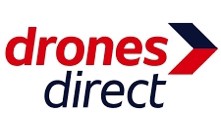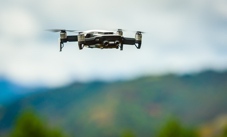 Drones come in many shapes and sizes with many different purposes. Whether you’re looking to buy a drone for your photography business, you want to take it up as a hobby or perhaps your child has asked you for one for Christmas, there are plenty of different makes and models on the market. If you don’t even know where to start, check out our buying guide below for a snapshot of the leading brands and the features you should look out for when making your purchase.
Drones come in many shapes and sizes with many different purposes. Whether you’re looking to buy a drone for your photography business, you want to take it up as a hobby or perhaps your child has asked you for one for Christmas, there are plenty of different makes and models on the market. If you don’t even know where to start, check out our buying guide below for a snapshot of the leading brands and the features you should look out for when making your purchase.
Shops With Drone Offers
Drone Buying Guide

First we had the selfie, then we had the selfie stick, and now we can take it one step further by launching a drone and taking a photo of ourselves from the sky. Technology that was once used mainly by professional photographers and filmmakers, as well as in rescue and recovery operations or anywhere else you might need an aerial assessment, is now widely available on the high street with a plethora of hobby budget devices available.
What Is a Drone?
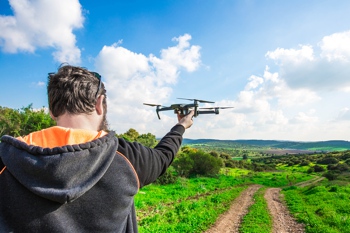 A drone is an unmanned vehicle capable of flight. You have probably heard of the drones used in military operations, but these are generally very large, being capable of transporting missiles. Hobby drones are much smaller, but operate on the same principals, with a person using a controller of some sort that is capable of sending a signal to the drone in order to direct its movements. Most hobby drones and those used on a semi-professional basis are quadcopters.
A drone is an unmanned vehicle capable of flight. You have probably heard of the drones used in military operations, but these are generally very large, being capable of transporting missiles. Hobby drones are much smaller, but operate on the same principals, with a person using a controller of some sort that is capable of sending a signal to the drone in order to direct its movements. Most hobby drones and those used on a semi-professional basis are quadcopters.
These are drones with four propellers, one on each corner, with some drones having an X shaped frame and other drones having an H shaped frame. In the centre of the drone, there is a gyroscope, which is a piece of technology that assesses the direction of travel of the drone and determines what the speed of each propeller should be in order to move in the correct way. Hobby drones are often fitted with cameras that take photographs and record video, or allow you to have a first-person view from inside the drone so you can see what it is like to be flying through the air.
Why You Might Want a Drone
Until recently, drones have been a very niche technology, but if you are at all interested in photography, then they are certainly worth investing in. A drone can capture stunning images with aerial shots, giving you a unique perspective. You can see what your house looks like from above, see the top of a waterfall whilst you stand at it’s base, or get amongst the tree canopy to spot the birds.
Drones let you capture those special moments with family and friends in a more superior fashion to the selfie, as you can take wide group shots without anyone needing to be standing behind the camera. What’s more, if you love sharing your images on social media, then images captured by drones will certainly help you to stand out from the crowd.
However, it’s not all about photography. Some drones are designed to be raced at high speeds, whilst others are capable of some pretty cool flips and other stunts, making them a 21st century version of radio controlled cars.
Finally, drones can be an educational experience, with some manufacturers including the ability to programme the drone so that you can instruct it to follow a series of steps. Software packages are available for some drones that use visual programming language that can provide a fantastic introduction to programming for children and adults who have no previous experience in the field.
Drones for Kids & Adults
Let’s be honest, drones are essentially toys, which is why children beg their parents to be able to take a turn. But if you have spent a few hundred pounds on a drone that is capable of capturing high definition images, you probably won’t be pleased when your eight year old crashes it into a lake. Instead, you could opt for a drone that is better suited for children.
Drones for Kids
Drones for kids tend to be significantly cheaper than drones aimed at adults. This is understandable, since, as any parent knows, most kids aren’t that careful with their toys. As a result, most drones aimed at children lack a camera, and are more like a flying version of a remote-controlled car. You don’t tend to get smart phone connectivity with drones for children either. That being said, some of the more pricier children’s drones do include these features, but they tend to have an age suitability rating of 14+ and are better suited for teenagers and young adults who are interesting in taking up drones as a hobby.
Most drones for children come in the standard quadcopter form, but you can get some alternative versions, such as a replica helicopter or a flying target for Nerf gun practice. There’s even a Toothless drone, based on the character from How to Train Your Dragon and for fans of Harry Potter, there is a flying snitch drone!
Drones for Adults
Drones for adults tend to come in three different categories. First, there are entry level drones, aimed at the casual hobbyist and beginner. They are the lowest priced drones (other than those aimed at children) and usually offer limited flight times. They often include cameras, but the image quality can be poor. However, they can usually perform tricks, such as flips, and tend to be ready to fly straight out of the box, with no programming or construction required and, as a result, they are popular Christmas gifts.
For the keen hobbyist, there is a large range of camera drones. The basic models are pricier than the entry level drones, but they have additional features such as HD cameras and obstacle avoidance. Many basic camera drones can be flown outdoors. As the price of camera drones increases, so does the capability of the drone, and so at the top end of the camera drone range you have those that are used by professional photographers etc, with the ability to shoot in 4K, extended battery life, and further features, such as changeable camera lenses and GPS tracking.
However, for many drone enthusiasts it’s not about taking amazing photographs, it’s about flying. Racing drones are built for speed, with some being able to go over 80mph. They are small, light, but very responsive, and are often flown via the use of a first person camera so you can fly the drone as though you were sat inside it. Stunt drones are similar to racing drones, but have the ability to perform flips.
Popular Brands of Drones
The drone market has exploded in recent years, with the success of manufacturers, such DJI and Parrot, inspiring a flood of lower cost imitations. But how can you be sure that you’re choosing the right drone for you needs and budget? Here we look at some of the more popular brands and what they have to offer.
DJI
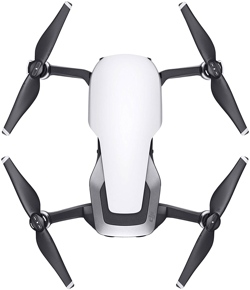 The market leader in drone technology is DJI. It’s thought that the manufacturer is responsible for over 70% of the drone market and it is the brand of choice for professionals. Much of the footage that you may have seen in the BBC series Planet Earth II was shot using DJI technology, which should give you some indication on the level of quality that this brand provides.
The market leader in drone technology is DJI. It’s thought that the manufacturer is responsible for over 70% of the drone market and it is the brand of choice for professionals. Much of the footage that you may have seen in the BBC series Planet Earth II was shot using DJI technology, which should give you some indication on the level of quality that this brand provides.
DJI’s Mavic range is aimed at consumers, such as enthusiast hobbyists and beginners who have a bit more cash to spare. The Mavic Mini is an ultra-light drone with impressive capabilities. Weighing just 249g it has a flight time of 30 minutes and comes with a remote controller that can connect to your smart phone and provide a HD video feed from up to 4km away. It’s also packed with additional features that give it incredible stability when flying and it has an impressive flight time of around 30 minutes. The Mavic range also includes larger drones, aimed at both the professional and the keen hobbyist, all of which contain sophisticated and powerful technology that makes taking to the skies and capturing stunning images a truly joyful experience. Mavic drones also feature folding propellers, making them very portable.
The Mavic range is probably best suited to the average consumer, but for those who want professional level images from their drones and have money to spare, then DJI’s Phantom range is the one to go for. With autonomous obstacle sensing and avoidance, fast flying speeds, and 20 megapixel cameras capable of shooting video in 4K, these drones will produce images that will make you stand out from the crowd.
Of course, accidents do happen, and one reason why so many consumers opt for DJI is the care packages they provide for an additional charge, with the option to receive a replacement part without needing to wait for a damage assessment.
Revell
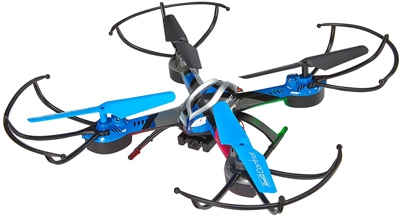 At the other end of the market to DJI, you have Revell. Revell’s drones are low cost and generally aimed at children and beginner hobbyists with limited funds. The company was founded over 70 years ago, producing moulded plastic toys. Today, they largely specialise in model making toys but they also have a selection of drones that can be found in various stores on the UK high street, including Argos. Their collection of quadcopter drones includes the Technick Venom Build Your Own Quadcopter Drone, which is a stunt drone that requires self-assembly and is aimed at teenagers and adults. For younger children, the Revell Control Quadcopter is a police themed drone with a light up frame that can be used indoors or outdoors and comes with a simple controller.
At the other end of the market to DJI, you have Revell. Revell’s drones are low cost and generally aimed at children and beginner hobbyists with limited funds. The company was founded over 70 years ago, producing moulded plastic toys. Today, they largely specialise in model making toys but they also have a selection of drones that can be found in various stores on the UK high street, including Argos. Their collection of quadcopter drones includes the Technick Venom Build Your Own Quadcopter Drone, which is a stunt drone that requires self-assembly and is aimed at teenagers and adults. For younger children, the Revell Control Quadcopter is a police themed drone with a light up frame that can be used indoors or outdoors and comes with a simple controller.
For those who are interested in aerial photography, Revell’s collection of drones also features those with cameras for image capture and video recording. They don’t have the same level of features as those from DJI, but they offer great value for money and are ideal for those just starting on their drone journey. At the top end of Revell’s camera range is the Demon Quadcopter that is capable of flying for up to 20 minutes and comes with a 720p HD camera. It also has the ability to perform flips and can be used indoors or outdoors.
Parrot
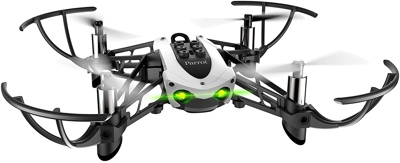 Parrot are a French company who were founded in 1994 and originally specialised in hands free Bluetooth technology. They launched their first drone on the market in 2010 and have become a popular choice for hobbyist drone users. More recently, they have expanded their drone business by taking on a contract with US military, which will no doubt lead to further innovations in their drone technology in the future.
Parrot are a French company who were founded in 1994 and originally specialised in hands free Bluetooth technology. They launched their first drone on the market in 2010 and have become a popular choice for hobbyist drone users. More recently, they have expanded their drone business by taking on a contract with US military, which will no doubt lead to further innovations in their drone technology in the future.
Parrot’s flagship drone is the ANAFI and many critics agree that this is a serious contender to the DJI Mavic Air. It’s a folding quadcopter that can easily fit in a rucksack. It’s capable of shooting in 4K video and capturing high quality image stills, with lossless zoom and image stabilisation. It has a flying time of around 25 minutes, but it does lack obstacle avoidance, so you have to be extra careful when flying around trees and other objects. The ANAFI also comes as a “first person view” version with goggles that display the view from the drone’s camera, giving you a fully immersive flying experience.
Parrot’s other drones include the Bebop 2, a fairly compact drone that can fly for up to 20 minutes and capture HD video. It’s a mid level drone in terms of pricing, and includes additional features, such as GPS tracking, so it can follow you as you move. Alternatively, the Parrot Mambo is a much lower priced drone that is more aimed at those wishing to perform stunts and tricks. It has powerful sensors making it very stable when flying and even includes an auto-pilot in case you let go of the controls for any reason. It has a vertical camera, but the image quality is not that great.
However, with the Parrot Mambo you can mount additional accessories, including a HD camera (with goggles available for first person view), a cannon shooter that lets you shoot targets with pellets, and a grabber that can carry lightweight objects. As a result of these additional accessories that can be purchased separately, the Mambo is a great choice for those who are interested in drones, but are not clear on whether they prefer the stunt side of drones, or the photography side. The Mambo can also be programmed through third party software, which adds an educational value to the device.
Sky Viper
 For an entry level priced drone, the Sky Viper is pretty impressive. It’s equipped with a HD camera and a 120 degree wide angled lens, plus it’s capable of some nifty stunts. It’s easy to fly with auto modes that maintain altitude, and uses GPS to self correct. What’s more, if you take your hands off the controller, the drone will stop in mid air, so there’s less chance of it going astray.
For an entry level priced drone, the Sky Viper is pretty impressive. It’s equipped with a HD camera and a 120 degree wide angled lens, plus it’s capable of some nifty stunts. It’s easy to fly with auto modes that maintain altitude, and uses GPS to self correct. What’s more, if you take your hands off the controller, the drone will stop in mid air, so there’s less chance of it going astray.
It’s one of the cheapest camera drones on the market, so is perfect for those on limited budgets, and as a gift for older children. There’s also a stunt version, and a first person view version that comes with a headset. However, as you might expect from a low cost range of drones, the flight time is pretty limited, with around 5 minutes on a full charge.
Others
GoPro
GoPro is best known for its mounted cameras that are used to provide exhilarating footage from outdoor activities, such as mountain biking and climbing. They had a brief foray into the drone market, but withdrew in early 2018, citing a market that was simply too competitive. However, you can still purchase the last drone they produced, the GoPro Karma, from high street stores such as Argos. The Karma Drone is a versatile piece of kit if you’re already using GoPro tech as it uses existing GoPro cameras, but it lacks many of the features of other drones in a similar price bracket.
Ryze Robotics
Ryze Robotics is a start-up company from China that most people have probably never heard of. However, it’s got big name support, specifically, from DJI and Intel. Ryze released a drone in January of 2018 that claimed to offer a lot of features for a fairly low price. However, what set it apart from other start ups claiming much the same, was the support provided by DJI.
The Ryze Tello drone benefits from DJI’s intelligent flight control system making it considerably more stable than other drones in this price range, plus it includes a 5mp camera and 720p video recording. Like several other drones, the Tello can be programmed using third party software, adding an additional educational element.
Potensic
Potensic is an innovative company largely selling through Amazon. Their products have been highly commended not only by consumers but also by professional reviewers in the tech industry. Potensic has a collection of affordable drones for the beginner or older children. At the bottom end of its range it has drones that are essentially toys, whilst at the top end of its range is a foldable GPS drone with a 2K camera and a flight time of around 20 minutes.
Features to Look Out For
Drones range in price from tens of pounds to several hundred, with the top end selling for a couple of thousand or more. When making your drone purchase you want to look for the best possible features that can be included in your budget, so here we take a closer look at the sorts of things you need to look out for.
Camera & Video Quality
 For many drone users, the ability to capture images at height is a key selling point. So, when choosing your drone you want to be sure that you have the best possible camera for your budget. The cheapest camera drones on the market often have very low resolution cameras and the images they take will be grainy. The higher the resolution number, the better quality the image, with cameras capable of capturing 4k resolution images providing the best results.
For many drone users, the ability to capture images at height is a key selling point. So, when choosing your drone you want to be sure that you have the best possible camera for your budget. The cheapest camera drones on the market often have very low resolution cameras and the images they take will be grainy. The higher the resolution number, the better quality the image, with cameras capable of capturing 4k resolution images providing the best results.
It’s not just about resolution, as there are added features that improve the images taken by the camera. A fixed camera can only take images in one direction, whilst a camera mounted on a gimbal, a device that can move the camera around as the drone moves, will be able to capture images in multiple directions and maintain stable footage as the drone travels.
Battery Life & Flight Time
As with many other products in the smart age, battery life in drones has not kept up with the rest of the technological advances in these devices. Even drones used by professionals have a limited battery life resulting in a maximum flight time of around 30 minutes. Cheap drones will have a flight time of 4-5 minutes, and anything above that is going to cost extra.
Some drones include an extra battery so you can have one available to swap out, whilst some manufacturers have packages available that include extra batteries, a case, and spare propellers.
Sizing
Drones come in a range of sizes, but consumer drones are generally on the smaller side, weighing a few kilograms or less. If you are planning on taking your drone out with you on day trips, hikes, or on holiday, then you want something that isn’t too heavy and doesn’t take up too much room in your bag. Many drones have foldable propellers so that they pack down small and can fit in a rucksack.
However, the main issue that needs to be considered when it comes to a drone’s size is how it fits in with flight regulations. Unless you have been living under a rock lately then you are probably aware of the recent issues that were caused at Gatwick airport by a drone flying in the area. In response to this and other issues caused by drones, the UK government has introduced new laws that state that any drone that weights over 250g must be registered with the Civil Aviation Authority, and that any drone for recreational use must be under 20kg.
Compatibility with Smart Phones
Although many drones are controlled by separate controllers, some are capable of being controlled solely by a smart phone. In addition, drones that have controllers often link to smart phones to stream footage and send images, etc. For this reason, you need to ensure that any drone you choose that requires a smart phone to get the most out of its features is compatible with your device.
Some drones can also be programmed via third party software and if you want to add an additional educational element to your drone then it’s worth doing some research to see what apps are required for this, and if they are available on your device.
GPS
Most of the cheaper drones won’t include GPS capabilities but if you are looking at investing a few hundred pounds in a piece of kit then GPS is certainly a function you won’t want to do with out. In drones that don’t have GPS the position of the drone is entirely determined by the pilot. Sounds fine on paper, but human beings are very prone to making errors and this means accidents can happen. GPS reduces the possibility of human error, and thus the likelihood that your drone will end up in the lake.
Drones that have GPS capabilities use information from satellites, rather than relying on human eye and hand coordination. As a result they can autonomously hold themselves at a fixed altitude and location, and they can also remember the exact location they departed from, meaning that you can instruct your drone to “return home”, i.e., return to the point where you launched it. Some drones are also capable of autonomous flight using pre-programmed GPS way points to follow a route.
Range & Speed
Some of the pricier racing drones on the market can reach speeds of 70 to 80 mph but for a mid-level drone you are probably looking at around 30mph. Obviously if racing is something you would like to pursue then the top speed is a number you will want to take note of. Range is another factor you need to consider. Just because a drone can do 30mph and fly for 5 minutes, doesn’t mean that it necessarily has a range of 2.5 miles, as the range is not solely determined by the drone’s speed and battery time.
Drones need to be able to communicate with the controller and they do this via radio waves. The ability of your drone to communicate with the controller over increased distances is affected by the frequency used and other factors. Some of the more expensive consumer drones can go up to five miles away from the controller but when you are first learning to fly you will certainly want to keep it within eyesight to help avoid any hazards.



